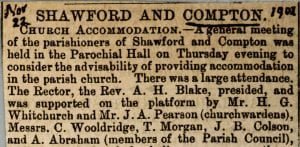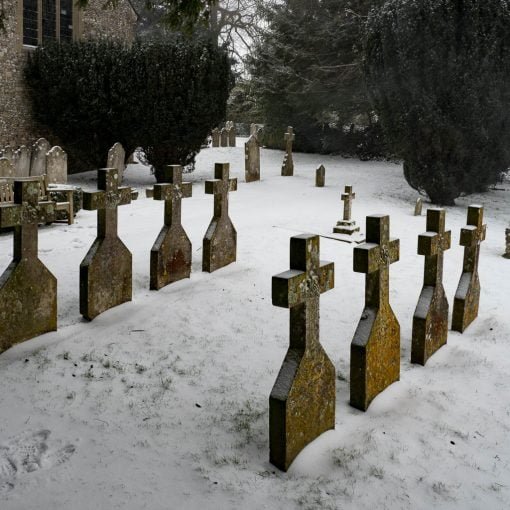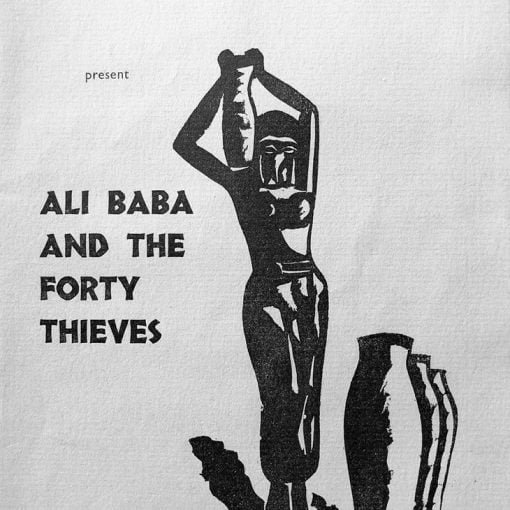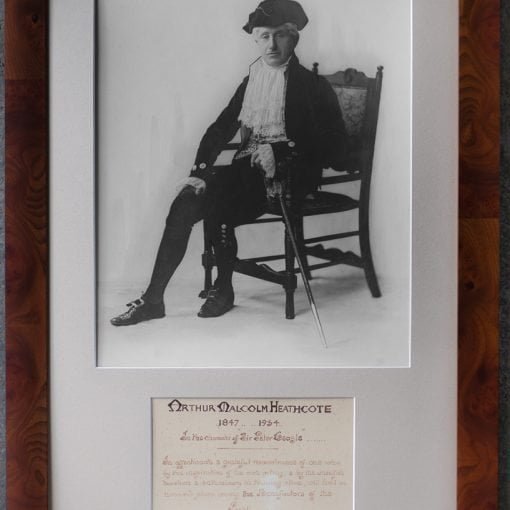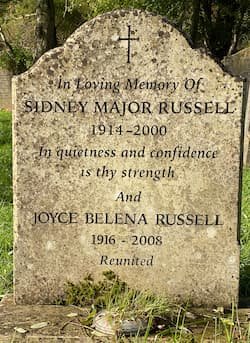Shawford and Compton Church Accommodation
Hampshire Chronicle and General Advertiser 22 November 1902
Full text of the report, reproduced by permission of the Hampshire Record Office – reference number TOP78/3/3
A general meeting of the parishioners of Shawford and Compton was held in the Parochial Hall on Thursday evening to consider the advisability of providing accommodation in the parish church. There was a large attendance. The Rector, the Rev. A. H. Blake, presided, and was supported on the platform by Mr. H. G. Whitchurch and Mr. J. A. Pearson (churchwardens), Messrs. C. Wooldridge, T. Morgan, J. B. Colson, and A. Abraham (members of the Parish Council), while in the body of the hall were, among others, Capt. Forrest, Capt. and Mrs. Nixon, Mrs. and Miss Hardy, Mr. Hepherd, Mr. Colebrook, Mr. Eames, Mr., Mrs., and Miss Lyne, Mr. and Mrs. Burnett, Mr. and Mrs. C. G. Halliday, Mr. Stevens, Mr. Burton, etc.
The Chairman read the circular convening the meeting as follows: – “It is felt desirable that a general consultation should take place on the question of our Parish Church accommodation, and whether the time has not arrived when a new church should be built.”
The Rector stated the matter for discussion was of grave import for the parish, and quoted the words of the Bishop at his induction to the effect that it was a question which would have to engage the earnest attention of the parish at no distant date.
The Rector believed it was a fact that the parish had increased during the past year by more than fifty persons, and if this state of things continued it would be quite impossible to provide sufficient accommodation in the present small church, which being built for 150 has to provide for 600, consequently it would cause a widespread feeling of discontent in the parish, and people would go elsewhere to worship. At present he was only concerned with the discussion of the subject, and he wished to ask the audience not to be dismayed with the magnitude of the undertaking. He had two excellent churchwardens, and he believed they had been called his (the Rector’s) guardian angels.
The first resolution was proposed by Mr. J. A. Pearson as follows: – “That this vestry meeting considers that an increase of our parish church accommodation should be provided, and that a committee be elected to consider the matter, with power to add to their number.” Mr. Pearson said they all agreed with that excellent resolution, and what they had to consider was whether they would have the old church enlarged, or build a new one.
Personally he was in favour of enlarging the old church, but before pledging himself to either scheme, he thought the matter ought to be thoroughly thrashed out in committee. Mr. C. Woldridge, in seconding, said, assuming a new church be built, it seemed to him they were under an obligation to provide for the present population, and allow a little margin, as future new comers should contribute to the cost of any enlargement necessary later on consequent on their advent into the parish [applause]. The resolution was carried unanimously.
Mr. T. Morgan, in proposing the next resolution, viz.: – “That this meeting, while fully recognising the responsibility of preserving the old church as an ancient historical building where the worship of God has been carried on for upwards of a thousand years, is of opinion that it is desirable that immediate steps should be taken for the erection of a new church,” said he was in favour of a new church. He considered it would be most unkind to pull about the old edifice, which had stood for a thousand years as a place of worship. It seemed to him it would be difficult to ventilate a church which had sunk as their old one had done, and it would be almost an impossibility to add new aisles or in any way to enlarge the old building. He thought if a strong and influential committee were appointed the whole matter would be carried out as it ought to be. As a practical man he should prefer to support the Rector, and provide the accommodation in the way of a new church.
Mr. E. Eames seconded the resolution, and supported the idea of a new church most heartily. He also thought it would be a pity to interfere with the old building, as in a few years it would probably again become inadequate. He firmly believed if the matter were taken up heartily they would overcome all difficulties. He hoped there would be a central site found for the church, and he felt sure the large owners of property would support the scheme, including the Ecclesiastical Commissioners.
Mr. E. Lyne was very much in sympathy with the whole scheme of a new church, and said he should always feel deeply interested in the parish, although probably he might be leaving. He thought it would be an act of vandalism to pull about the old church, and a sacrilege to interfere with the graves around the old edifice.
Mr. G. H. Kitchin thought the old church could easily be enlarged, and quoted details to support his opinion.
Mr. Eames thought it might be still useful as a mortuary chapel, or could be used for children’s services.
Mr. H. Whitchurch (Chairman of the Parish Council) felt it would all be a labour of love, and that it would be difficult to keep the purse strings tied up after that meeting. He stated that two sites had been offered, and wished God speed to the work, and hoped to have the new church as soon as possible.
Mr. J. B. Colson said he had much pleasure in supporting the resolution, although he did not altogether agree with a former speaker as to the impossibility of enlarging the old building. He considered it was quite possible to enlarge it. At one time a Saxon church existed where the present building now stands, although scarcely any trace now remains. The present church was in existence at the time of the Domesday Book, and galleries existed in the church at that time, and again up to thirty years ago. A gallery also existed on the north side.
An influential committee was then appointed with power to add to their number as follows : – Messrs. A. Abraham, A. A. Burnett, C. A. Burton, H. M. Colebrook, J. B. Colson, E. Eames, Capt. R. H. Forrest, Mr. C. Flight, Gen. Hardy, Messrs. C. G. Halliday, G. H. Kitchin, E. Lyne, T. Morgan, and T. W. Richards, Capt. Nixon, Messrs. E. Nuthall, W. G. Toogood, E. Webb, A. W. Hayward, C. Wooldridge, W. H. Hepherd, J. Stevens, Rev. Du Boulay, Messrs. E. Bowker, E. Bailey, B. J. Lee, A. Twitchen, and J. Taylor, the Misses Bailey, Misses Howell, Mrs. Woodman, Miss Midwinter, Mrs. Eames, Mrs. Blake, Mrs. Escombe, the Rector (the Rev. A. H. Blake), Mr. J. A. Pearson, and Mr. G. H. Whitchurch.
All the resolutions were carried unanimously, and a hearty vote of thanks was accorded the Rector for presiding.
At the close, with the permission of the Rector, the Chairman of the Parish Council announced that a balance in hand of £2 8s. 4d. remained from the Coronation festivities fund, and asked permission of that meeting to devote the same to the lighting fund (lamps, &c.), for the parish, these improvements being already carried out and much appreciated. The necessary consent was unanimously given by the meeting on a show of hands.
A vote of thanks was also given to Mr. H. M. Colebrook, who ably carried out the duties of secretary.
See also: The 1905 extension of Compton Church

